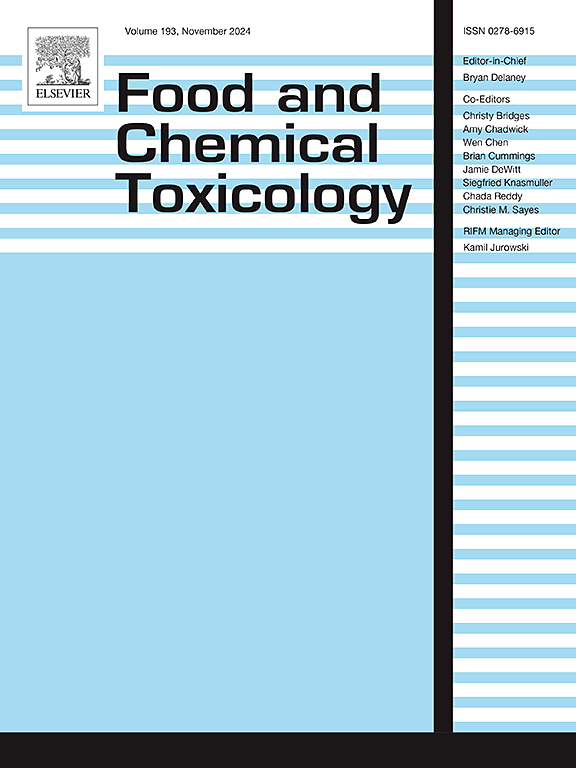Sultani无籽葡萄中农药残留的定量和风险评估:对消费者安全的影响
IF 3.5
3区 医学
Q2 FOOD SCIENCE & TECHNOLOGY
引用次数: 0
摘要
农药在葡萄种植中经常被用于控制各种病虫害,但其残留物会积聚在葡萄产品中,引起人们对消费者安全的担忧。本研究旨在评估土耳其生产的Sultani无籽葡萄中268种农药残留的发生情况,特别关注其对急性和慢性健康风险的潜在影响。在液相色谱-串联质谱分析的473个葡萄样品中,只有11个样品(2.3%)未检测到农药残留。在462个样本(97.7%)中鉴定出可量化的农药残留水平,其中52个样本超过了欧盟最高残留限量。葡萄中最常见的农药是氨曲霉素、甲螨灵、环虫腈、嘧虫胺、螺虫脒和氟吡灵,发生率超过50%。长期饮食暴露评估显示,葡萄中的农药残留不会对土耳其成人和儿童构成重大健康风险,因为危害商数仍远低于临界阈值。然而,在部分样品中,特别是对儿童而言,乙酰氨脒、甲维菌素苯甲酸酯和高效氯氟氰菊酯的急性暴露风险超过了可接受的限度。这些调查结果强调了加强农药监测和遵守法规的重要性,以确保消费者安全并促进采用虫害综合管理做法。本文章由计算机程序翻译,如有差异,请以英文原文为准。
Quantification and risk assessment of pesticide residues in Sultani seedless grapes: Implications for consumer safety
Pesticides are frequently used in viticulture to control various pests and diseases, but their residues can accumulate in grape products, raising concerns regarding consumer safety. This study aimed to evaluate the occurrence of 268 pesticide residues in Sultani seedless grapes produced in Turkey, with a particular focus on their potential implications for both acute and chronic health risks. Of the 473 grape samples analyzed by liquid chromatography-tandem mass spectrometry, only 11 samples (2.3 %) were free from detectable pesticide residues. Pesticide residues at quantifiable levels were identified in 462 samples (97.7 %), and 52 of these samples exceeded the European Union Maximum Residue Levels. The most frequently recorded pesticides in grapes, with occurrence rates exceeding 50 %, were ametoctradin, metalaxyl, cyprodinil, pyrimethanil, spirotetramat, and fluopyram. Chronic dietary exposure assessments revealed that pesticide residues in grapes do not pose substantial health risks to both adults and children in Turkey, as hazard quotients remained well below critical thresholds. However, acute exposure risks for acetamiprid, emamectin benzoate, and lambda-cyhalothrin exceeded acceptable limits in a fraction of the samples, especially for children. These findings underscore the importance of enhanced pesticide monitoring and regulatory compliance to ensure consumer safety and promote the adoption of integrated pest management practices.
求助全文
通过发布文献求助,成功后即可免费获取论文全文。
去求助
来源期刊

Food and Chemical Toxicology
工程技术-毒理学
CiteScore
10.90
自引率
4.70%
发文量
651
审稿时长
31 days
期刊介绍:
Food and Chemical Toxicology (FCT), an internationally renowned journal, that publishes original research articles and reviews on toxic effects, in animals and humans, of natural or synthetic chemicals occurring in the human environment with particular emphasis on food, drugs, and chemicals, including agricultural and industrial safety, and consumer product safety. Areas such as safety evaluation of novel foods and ingredients, biotechnologically-derived products, and nanomaterials are included in the scope of the journal. FCT also encourages submission of papers on inter-relationships between nutrition and toxicology and on in vitro techniques, particularly those fostering the 3 Rs.
The principal aim of the journal is to publish high impact, scholarly work and to serve as a multidisciplinary forum for research in toxicology. Papers submitted will be judged on the basis of scientific originality and contribution to the field, quality and subject matter. Studies should address at least one of the following:
-Adverse physiological/biochemical, or pathological changes induced by specific defined substances
-New techniques for assessing potential toxicity, including molecular biology
-Mechanisms underlying toxic phenomena
-Toxicological examinations of specific chemicals or consumer products, both those showing adverse effects and those demonstrating safety, that meet current standards of scientific acceptability.
Authors must clearly and briefly identify what novel toxic effect (s) or toxic mechanism (s) of the chemical are being reported and what their significance is in the abstract. Furthermore, sufficient doses should be included in order to provide information on NOAEL/LOAEL values.
 求助内容:
求助内容: 应助结果提醒方式:
应助结果提醒方式:


